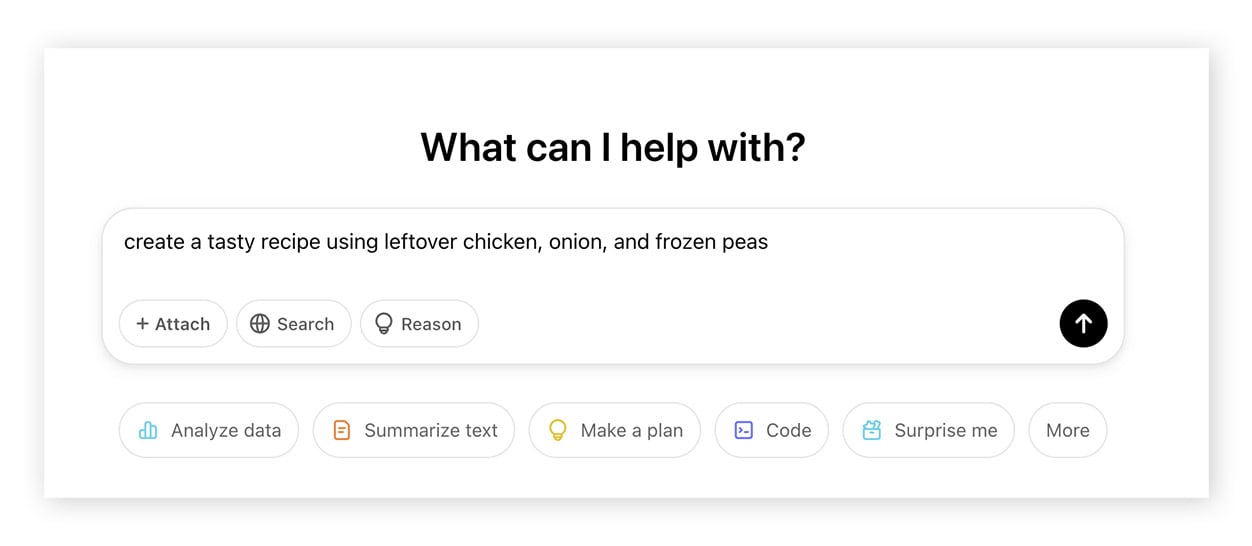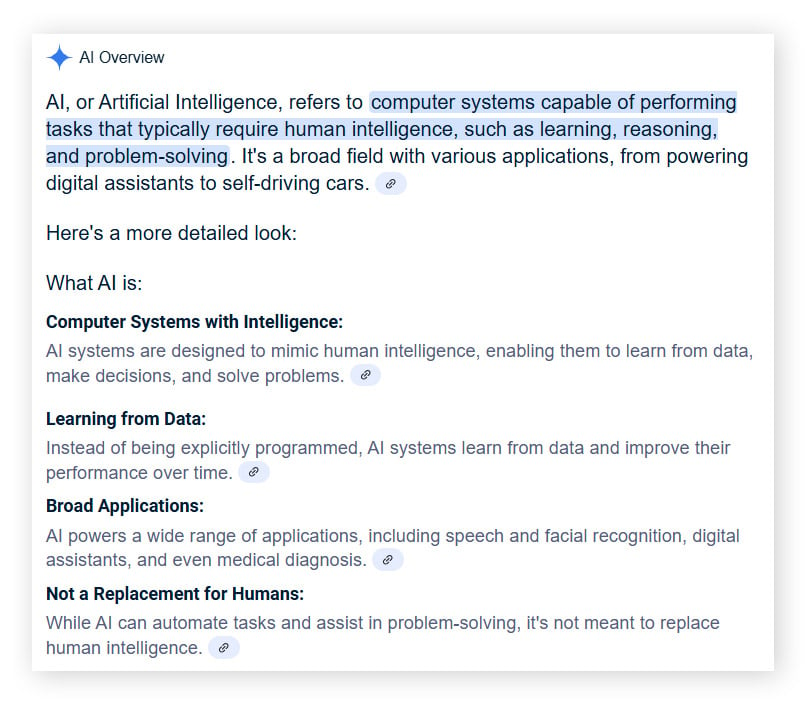What is generative AI?
Generative AI is a type of AI technology that generates content in response to prompts inputted by users, drawing from patterns in existing data that it was “trained” on. Its complex predictive algorithms can be used to create text, videos, images, and more, or simply to interact with a user in convincingly human conversations on platforms like ChatGPT.
Despite being a relatively new AI technology, hitting the mainstream in 2022 with ChatGPT’s public release, the GenAI field is developing rapidly, with vast adoption already a reality across many industries. Today, it’s commonly used to power chatbots, coding assistant tools, translation apps, graphic design platforms, and more.
What does generative AI mean for the future of technology? It’s a pretty big deal. GenAI tools can perform time-consuming human tasks in seconds and at very little cost. It has the potential to improve human productivity and innovation in countless ways. For example, GenAI is leading to major breakthroughs in cancer detection by analyzing images of tissue.
It’s also changing how we surf the web, with AI capabilities gradually being integrated into major web browsers like Google Chrome, and it’s likely to enable rapid development of the Internet of Things (IoT) field by offering new for the physical devices we use each day (e.g., smart home technology) to interface with the internet.
How generative AI works
While the inner workings of GenAI programs are extremely complex, the simple version is that they analyze a user’s prompt and generate a suitable output based on patterns learned from vast amounts of training data — including text, images, and other media sourced from the internet, books, and more.
In other words, GenAI predicts the most likely sequence of words or images that would form a relevant response to a given prompt, drawing on its understanding of statistical relationships found in the data it was trained on. While GenAI might not always get it right, new and improved models are constantly being released, with updated training datasets meaning responses are likely to continually improve in accuracy and relevance.
Here’s a more detailed breakdown of how generative AI works:
-
A user provides a prompt: This might be a question, a task, or a description of something to create (like an image). A prompt might read, “Write a short horror story about a robot and an abandoned house.” Or, “Create an image of a kitten roundhouse kicking a clown in the style of a Michelangelo painting.”
-
The AI interprets the prompt: The GenAI program breaks the prompt down into fragments, called “tokens.” It compares patterns in the tokens that make up the prompt to similar patterns from its training data and uses what it finds to predict a response that best satisfies the prompt.
-
The AI generates an output: This output may be text, audio, video, or another form, depending on the AI tool and the prompt. Because GenAI analyzes each prompt separately, it’s highly unlikely to give the same reply twice. Outputs are generally unique and original, even if the same prompt is used multiple times.
 A user inputs the prompt, “Create an image of a kitten roundhouse kicking a clown in the style of a Michelangelo painting,” and the generative AI interprets it, generating an image.
A user inputs the prompt, “Create an image of a kitten roundhouse kicking a clown in the style of a Michelangelo painting,” and the generative AI interprets it, generating an image.
It’s important to remember that despite AI’s human-sounding output, it doesn’t think, reason, or feel as a human does. In fact, GenAI isn’t intelligent at all. Any illusion of intelligence is only based on its ability to make statistical predictions based on massive data sets. Much like a calculator, it responds to input based on its programming.
Generative AI models
You’ve probably heard about ChatGPT, the most popular GenAI tool, which Sam Altman, the founder of OpenAI, claims is being used by up to 800 million people. But this is just one example of a single type of generative AI.
There are lots of different types of generative AI models, including:
-
Large language models (LLMs): LLMs like the “Generative Pre-trained Transformer,” or GPT, that powers ChatGPT are trained specifically on text sources. Their purpose is to recreate and “understand” human language. LLMs use deep learning (an advanced type of machine learning) to predict responses to text-based prompts.
-
Diffusion models: These models are used to generate images. They work a bit like creating a painting in reverse, first creating a noisy, chaotic image and then gradually refining it until it’s deemed to satisfy the user’s prompt.
-
Transformer models: These models are the backbone of modern GenAI tools. They use a method called tokenization to break down prompts into small parts (called tokens) that the algorithm can understand. The algorithm then looks for connections between tokens and its training to generate nuanced, human output and realistic images.
-
Multimodal models: These models integrate many data sources — often including text, images, and audio — to facilitate the generation of multiple types of content. This enables a single GenAI tool to perform a variety of tasks.
-
Foundational models: These models serve as the foundation for many AI functions, providing the core intelligence for generating text, images, and more. They’re trained on huge amounts of data and can be fine-tuned and updated for specific tasks. LLMs, diffusion models, transformer models, and multimodal models can all be foundational models.
-
Generative adversarial networks (GANs): These AI models combine two neural networks, each with a separate task. The first network creates content, and the other evaluates the content for accuracy and refines it if necessary. They’re typically used to generate images and videos and can also be employed in the creation of deepfakes.
-
Autoencoders: These GenAI tools compress data and reconstruct it to identify patterns. For example, they can analyze a human voice and break it down into features that the algorithm can recreate. They are often used for voice synthesis and deepfakes.
Fundamentals of a generative AI model
Creating a generative AI model requires a great deal of investment and computing power. While costs are dropping, it still costs millions to build one. Here’s what it takes to create a GenAI model:
-
Quality training data: Models must be trained on massive amounts of data. All of that data must be labeled and categorized accurately for the AI to learn effectively and without bias.
-
Advanced neural networks: Neural networks are machine learning systems that power generative AI. They provide the computational framework that enables AI models to make predictions. GPT is an example (the neural network that powers ChatGPT’s models).
-
Computing power: Huge numbers of powerful computer chips are needed to run GenAI processes, requiring significant energy input.
These are just the basic necessities. Effective models also require constant moderation and training to improve their capabilities and prevent bias or harmful content generation. A massive effort by humans and machines is needed for this. It’s reported that OpenAI spends about $1.5 billion on staffing alone.
How generative AI has developed
Generative AI has been around in one form or another for decades — since the 1960s, in fact. Since then, scientists, linguists, and even philosophers have been hard at work designing and testing AI models. Here’s a quick look at how GenAI came to be.
1966
The first chatbot, named Eliza, was invented by MIT professor Joseph Weizenbaum. Eliza was programmed to identify keywords in prompts and reply with scripted responses.
1980
Developers Michael Toy and Glenn Wichman create the first procedurally generated game, titled Rogue. The game generated environments randomly, making every playthrough unique.
1986-2000
Breakthroughs in neural networks laid the foundations for computer vision (e.g.
facial recognition) and deep learning.
2010-2015
Apple releases the first mainstream AI-powered chatbot, Siri, and Amazon follows suit with
Alexa a few years later. Key GenAI models were developed, such as generative adversarial networks (GANs) and diffusion models, making huge advances in realistic text and image generation.
2016-2020
Google develops the transformer AI model, which becomes the foundation for today’s generative AI tools. OpenAI releases Generative Pre-trained Transformer (GPT), its groundbreaking LLM.
2022
OpenAI releases ChatGPT, a user-friendly chatbot that generates original text-based content and interactions. It gains over
100 million users within two months of its release.
2023
OpenAI releases GPT-4, a multimodal AI that generates text and images. Google and Bing incorporate AI into their search engines, and new GenAI tools emerge, such as Claude, Gemini, LLaMA, and Grok.
2024-present
GenAI goes mainstream. AI is integrated into countless consumer products, including social media, photo editing apps, and project management software.
Over 80% of businesses are using or exploring uses for AI, and
over 50% of Americans interact with AI daily.
How to use generative AI
There are many ways to use generative AI tools and countless use cases for the technology. The simplest way to use generative AI is to visit a GenAI tool website (like claude.ai) or download a GenAI app (e.g. ChatGPT).
From there, it’s as simple as typing a prompt into the text box. Here’s a step-by-step example using ChatGPT, the most popular GenAI tool.
-
Visit chatgpt.com. There’s no need to make an account to use the tool. However, making an account gives you more privacy options if you don’t want OpenAI to collect your data.
-
Type your prompt into the text box. You can ask a question, give the AI a task (e.g. create a tasty recipe using leftover chicken, onion, and frozen peas), or ask it to generate an image. If you don’t feel like typing, you can click the Voice icon to speak to the AI.

-
ChatGPT will automatically reply to your prompt. Its reply shouldn’t take more than a few seconds.

-
ChatGPT will remember your prompts and its responses within the same conversation. So, you can continue chatting about the topic or modify the task if you didn’t get what you were hoping for.

Most chat-based GenAI tools work similarly to ChatGPT, plus or minus various features like the ability to search the internet in real-time for additional context. However, there are also more specific ways to use generative AI, depending on your needs.
Developers can integrate GenAI into their tools by requesting an API from the model’s creator. This allows them to add AI capabilities to their own products or apps. You can also use GenAI when you perform a search via Google Chrome and other search engines like Bing. Google Gemini now automatically generates an AI response to searches on Chrome.

You may also notice that AI is popping up in apps that you’ve used before, such as Notion or Snapchat. All of these in-app AI functions are powered by GenAI models. If you use GenAI this way, just know that it won’t be as versatile as interacting with the AI directly.
Companies that integrate AI into their products limit the scope of the AI to improve specific services they provide.
Examples of generative AI tools
While ChatGPT is the best-known consumer-facing generative AI tool, it’s far from the only option. There are many GenAI apps, each with different training and capabilities. While it may seem that some of these tools are nearly identical in their function and output, their differences can have implications for your experience, safety, and privacy.
Here are some examples of popular generative AI tools.
-
ChatGPT: ChatGPT was the first mainstream GenAI tool, and it’s still the most popular. It began as a purely text-based LLM. Today, it’s a multimodal model that can generate text, audio, images, and code. ChatGPT is free to use at chatgpt.com or via the ChatGPT app.
-
Claude: Claude is a chatbot, like ChatGPT, built by Anthropic with a focus on long-form content generation and AI safety. It has a “Constitutional AI” framework, designed to ensure outputs follow pre-programmed ethical guidelines. Some sources claim this makes it safer to use than ChatGPT for users hoping to avoid bias or potentially harmful responses. However, Claude can currently only generate text and code.
-
Gemini: Gemini is Google’s proprietary GenAI, powered by its LaMDA LLM. Gemini functions much like ChatGPT, and it can generate text, images, and code. Gemini is also increasingly being integrated into Google’s other tools, such as Chrome and Docs.
-
Le Chat: Le Chat is a GenAI assistant built by Mistral, a French AI company. Like ChatGPT and Claude, it’s a conversational chatbot designed for generating text and code. Le Chat stands out for being based on Mistral’s open-weight models, which allow for transparency and community-driven development.
-
DeepSeek: DeepSeek is an open-source GenAI tool that rivals the quality of similar apps. DeepSeek was significantly cheaper to build and train than its counterparts, so it is seen as a breakthrough for GenAI development. But for practical purposes, it isn’t much different from tools like ChatGPT.
-
Dall-E: Dall-E is OpenAI’s image generator. Users describe what they want to see via text and the AI generates an image based on the prompt. Dall-E is built on a stable diffusion model and is available within ChatGPT to create images as part of a multi-modal experience.
-
Midjourney: Midjourney is another text-to-image generator known for creating highly detailed images. However, it doesn’t have a website. Instead, users can interact with the tool via the messaging app Discord.
-
Sora: Sora is OpenAI’s text-to-video generator. Much like Dall-E, users write a text description and Sora generates a 5-20 second video based on the prompt. While Sora has not been incorporated into ChatGPT (yet), it is currently available to paying ChatGPT customers at sora.com.
As some of the most popular mainstream GenAI tools, largely developed by reputable companies, all of the options in the above list are generally safe to use.
However, there are many GenAI tools that may not be quite as safe. Some third-party app developers integrate AI models from companies like OpenAI into their own apps using API keys, for example. But using the model from within that third-party app may be riskier than using it through the official ChatGPT app.
Untrustworthy third-party apps may have lower standards of AI cybersecurity, meaning they could be insecure or dangerous. Some, known as dark AI, may even be created by malicious scammers and hackers specifically to steal your personal information or infect your devices with malware.
The future of generative AI
Generative AI only recently hit the mainstream, so despite its popularity, it’s still only in the early stages of growth. Even so, the technology is advancing quickly, with 78% of companies using it in at least one function according to McKinsey research.
It’s likely that GenAI will continue to advance in both capabilities and adoption over the next decade, quickly becoming a more significant part of everyone’s daily lives. Here are a few potential developments we may see in the future of generative AI.
-
AI interactions will become more “human”: AI is currently good at replicating human responses via text. In the future, it will incorporate vocal audio, tone, humor, and even human physical features (AI avatars) to closely mimic real human interaction. GenAI will also become more interactive and aware of human speech patterns, allowing it to have more natural conversations. Many of these features are already in their early stages today, like in ChatGPT’s voice mode.
-
AI decision-making will improve: Currently, AI tools can respond to prompts. Soon, AI may be able to predict and anticipate your needs based on data from its memory. AI will be able to make context-based suggestions, take actions, and send alerts without being prompted.
-
AI will become more creative: AI’s ability to code, generate video, write, and design will likely continue to improve. In the near future, it will probably be capable of generating much more nuanced multimedia output, actively contributing to creative processes instead of just following a prompter’s instructions.
The benefits of using generative AI
While we probably can’t yet fully understand the full potential of generative AI, it’s already associated with lots of tangible benefits, including:
-
Productivity boosts: GenAI can help users accomplish tasks faster, and often at a lower cost, than they could manage alone. It can translate text into foreign languages in seconds, write professional emails and press releases, and make data-driven recommendations — all with a high degree of accuracy and efficiency.
-
Automation of repetitive tasks: GenAI tools can be programmed to handle time-consuming or tedious tasks like data entry, content editing, and customer support. Automating these functions could save businesses money and allow individual users to spend their time on more meaningful, creative, or strategic work.
-
Advanced data analysis: AI programs excel at analyzing large amounts of text or data instantly. They can draw intelligent conclusions from complex datasets in fields like law, medicine, finance, engineering, and research, helping professionals in these sectors make faster and more informed decisions.
-
Interpersonal applications: LLM-powered chatbots are designed to interact with humans in a friendly and empathetic way. They can mimic emotions like kindness and compassion, meaning they could be useful tools to tutor children or act as a personal assistant to medical professionals in stressful medical settings. One study actually found that medical patients preferred getting medical news from AI as opposed to doctors, because the AI was “perceived as more empathetic.”
Limitations and concerns around generative AI
Generative AI is not without drawbacks. The technology isn’t perfect, nor are the companies that run the AI models. A few of the risks of generative AI include:
-
Misinformation and hallucination: GenAI sometimes generates information that’s false, harmful, or misleading. This is called a hallucination, and it results from limitations in the AI’s processing and training. As human trust in AI grows, hallucinations have the potential to fuel fake news and other misinformation.
-
Bias and fairness: GenAI output can sometimes be biased and discriminatory in its responses. This can result from being trained on incomplete data or human biases present in the training material. For example, a hiring tool trained on past applicants may favor future applicants from particular schools or backgrounds.
-
Privacy concerns: AI apps collect your personal information when you sign up, and many record the conversations you have with the AI. For example, OpenAI stores ChatGPT chats for at least 30 days. This could present a privacy concern, heightening the risk of your sensitive data ending up in the wrong hands.
-
Copyright issues: OpenAI is facing a lawsuit led by The New York Times revolving around the fact that the company partially trains its models using copyrighted data without compensating the original owners. Copyright issues may become an even larger concern for AI companies in the future, as training sets expand to include more data.
-
Environmental impact: Training and running AI models require massive computing power, potentially resulting in high carbon emissions. Each reply generated by ChatGPT reportedly produces about 4.32 grams of CO2, which adds up at the scale the tool is operating at.
-
Abuse of the technology: GenAI is easily accessible to anyone for free, which means it’s also easy to abuse. Hackers and scammers can use these tools to create convincing phishing messages to trick people into handing over their personal information. They can also use AI to create deepfakes and voice clones to mimic others or run catfishing schemes.
Manage the risks of AI with Avast
Generative AI is arguably the most significant technological development since the internet, and it has major implications for both individuals and companies. Some of the consequences of its growth in popularity are likely to be positive, but GenAI’s universal availability and unpredictability can also put your safety and privacy at risk.
Don’t use GenAI tools such as ChatGPT without safeguarding your data and devices from inevitable lapses in security, whether they’re data leaks or outright scams. Protect yourself from fraudsters and malware with Avast Free Antivirus. Along with a powerful, built-in scam detection engine, Avast provides 24/7 protection against malware, data leaks, and much more, so you can more safely explore the many benefits of generative AI.



















